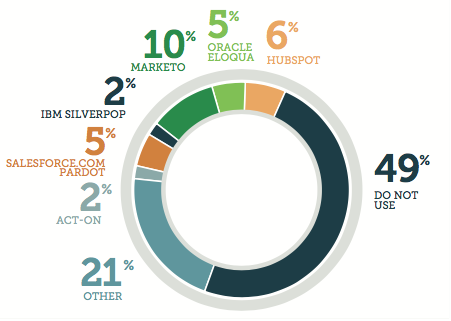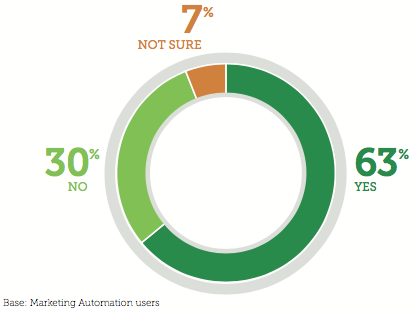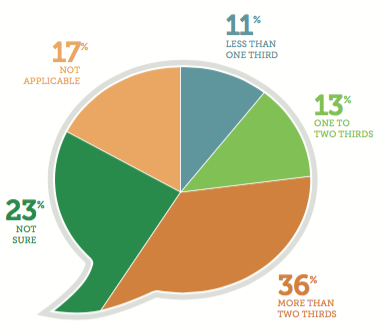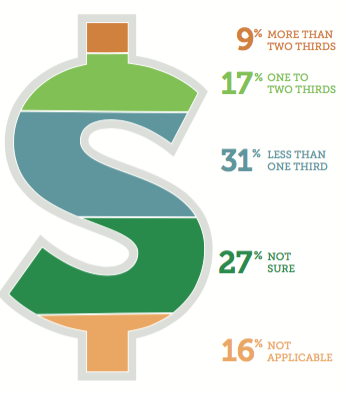Keeping the pace
Share
The results of the ‘B2B Marketing Outlook 2016’ are in, giving a comprehensive assessment of the shape of Australia’s business- to-business (B2B) marketers, and for the first time comparing the ‘best in class’ to the rest. By Ben Ice.
This article first appeared in The Love Issue, our June/July 2016 Marketing issue.
 Key findings from this year’s ‘B2B Marketing Outlook’ report, published by Green Hat, highlight the difficulty in measuring the ROI of B2B marketing tactics. Marketers also seem to be experiencing major challenges around uptake and successful execution of marketing automation technology, a lack of sales department follow-up of marketing leads, the importance of developing client personas as valuable data and which social platforms are most effective and popular among B2B marketers.
Key findings from this year’s ‘B2B Marketing Outlook’ report, published by Green Hat, highlight the difficulty in measuring the ROI of B2B marketing tactics. Marketers also seem to be experiencing major challenges around uptake and successful execution of marketing automation technology, a lack of sales department follow-up of marketing leads, the importance of developing client personas as valuable data and which social platforms are most effective and popular among B2B marketers.
For the first time this year, the results also include ‘best-in-class’ (BIC) analysis, which, for each category, separates the results for best practice marketers, so we, the readers, can gain insight into not only the industry, but its best – what they are doing differently, and how it influences their satisfaction with ROI.
The research, conducted from December 2015 to February this year, analysed responses from a pool of 448 participants.
Of the participants, 33% work in professional, scientific and technical services, 24% in information, media and telecommunications, 13% in manufacturing and supply chain, 9% in finance, banking and insurance, and 2% in public sector and government, with 19% working in ‘other’ roles across the B2B space.
A wide variety of sizes of organisations was covered, with 35% in the study working at organisations that turn over $5 million per year, 18% in organisations in the $5 to $24 million range, 11% in the $25 to $49 million range, 15% in the $50 to $499 million range and 21% whose organisations earn $500 million and over.
It was reported that 53% of respondents work in marketing teams of fewer than five full-time employees, 15% work in teams of five to nine, 12% in teams of 10 to 19 and 20% in teams of 20 and over.
Of the participants, 40% best describe themselves as ‘marketing professionals’, 18% as ‘head of marketing’, 20% as CEO/MD/director, 13% as head of sales, business development or agency marketer, and 9% as ‘other’.
Measurement
Measurement of marketing ROI was rated as the number one challenge for B2B marketers in this year’s results, making this the number one pain point for the second year running.
1. Measurement accuracy: ‘which of the following areas do you measure with at least 80% accuracy?’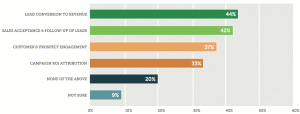
The difficulty can be shown in the first graph – where not one area saw a majority of those surveyed measuring with any sufficient accuracy, and only 33% reporting accuracy in campaign ROI attribution.
BIC marketers, in this area, were ones who attribute ROI successfully, and are able to develop an accurate picture of what is working for them.
“Best-in-class marketers are more accurately measuring their lead acceptance and follow-up rate by sales that lead conversion rates to revenue,” says Andrew Haussegger, managing director at Green Hat.
“What we’re starting to see now, with the massive flood of data through digital channels, is that the onus and the challenge has been served up to B2B marketers to understand better what part of their marketing is working and how they can optimise it. You can’t do that unless you’re getting some accurate measurement through.”
Interestingly, while measurement of ROI was listed as the number one challenge, it only rated fifth in terms of marketing priorities and objectives – falling in behind generating leads, nurturing and progressing leads, developing quality content, and growing brand awareness. While one may certainly argue that these objectives, key functions of a marketing professional, would take priority over measurement, for Haussegger, “it doesn’t add up like that” and should be focused on more intently.
“It comes back to the pressures that B2B marketers have from sales departments, or the CEO, to be relevant in the business. A lot of relevance in the business is measured by contribution to the pipeline. It’s disappointing, because this will be self-perpetuating. In that next year, when we do the research, the number one challenge again will be, ‘Well, I may have generated leads, but I’m not measuring properly, so that’s still my biggest challenge, but my objective next year is still to drive more leads,” says Haussegger.
Automation
Marketing automation has been picked up by 51% of B2B marketers, and its use is widely fragmented between the platforms Marketo, Hubspot, Oracle and Salesforce, all between five and 10% usage, with 21% of those using automation listing ‘other’.
2. Marketing automation adoption: ‘which marketing automation platform do you use?’
On average, 9% of marketing spend for 2016 budget will be allocated to marketing automation.
Across the whole study, only 45% are satisfied with ROI from marketing automation.
Haussegger believes this is because “people adopt automation without a clear plan as to what they want to do, and where they want to go with it”.
“There are some pretty sexy presentations that the marketing automation software vendors provide, and they can get marketing people pretty excited about the possibilities,” he adds.
The study reports that 56% of BIC marketers are very satisfied with automation ROI.
Lack of satisfaction with automation and its ROI, believes Haussegger, is a result of “confusion about what is marketing automation and what is not”.
3. CRM integration: ‘is your marketing automation platform integrated with your CRM?’
Automation, says Haussegger, goes far beyond “email marketing on steroids” and, for those who view it as such, without clear plan or vision, he warns, “If you automate chaos, you end up with more chaos.”
Lead follow-up
One perhaps alarming result in this year’s study was lead follow-up rates from sales departments, where only 36% of marketers report two-thirds or more of their generated leads are followed up by sales departments.
The fact that 27% were ‘not sure’ what percentage of marketing leads actually converted to sales, is further evidence of the apparent difficulty experienced in the measurement of marketing ROI.
4. Lead follow-up rate: ‘what percentage of leads passed from marketing to sales are followed up by sales?’
When broken down further, into organisation sizes, only 12% of marketers in large organisations are satisfied with leads followed up by sales, compared to 36% overall. This shows that smaller companies are getting better lead follow-up. For Haussegger, this “sort of makes sense, because there’s probably only a few salespeople and one or two marketing people, and they probably all sit next to each other”.
“You bring in the bigger teams, the dispersed teams in larger enterprises where the processes aren’t locked down properly, and those numbers are bad,” he says.
Haussegger puts this down to lack of sales integration with marketing focus. “The sales and marketing integration is broken in B2B marketing. There’s the traditional view that B2B companies are sales driven companies, not marketing companies. Sales have the larger voice, and their seat at the table is closer to the CEO, as often the CEO is ex sales.”
So what’s the solution here? First, sales and marketing departments need to align their goals more closely, and second, they need to focus on lead life cycle, suggests Haussegger.
“In some organisations, the head of marketing will carry the revenue goal as well.”
As far as the lead life cycle is concerned: “Marketing brings the people in, they generate interest, they nurture the lead, they take that lead to a point and they hand it over to sales. Sales then have to do their presentation and their negotiation to bring it to a customer. This is a lead life cycle – sales and marketing people need to work together – there’s only one lead life cycle, there’s not two.”
The final part of the life cycle and follow-up is around “collaboration and optimisation” follow-up. “It’s not a set and forget thing”, says Haussegger. “Book out the diaries for the next six months so you can have your program reviews, review your analytics and optimise the process.”
The vast array of online product and brand information has meant significant change in the way B2B buyers search for and choose product. “Sales need to be educated on the new buying process, the new way B2B buyers buy,” he adds.
B2B buyers can now “go through their buying process up to 90% of the way before they’ll call or engage the seller,” says Haussegger.
“They do this because they can.”
And while marketers are savvy to this trend of buying and are, therefore, moving on to content marketing and building their brand in the arenas where these buyers are engaging with material, sales professionals perhaps require more education to be brought up to speed.
5. Lead conversion to order rate: ‘what percentage of leads passed from marketing to sales convert to orders?’
Personas
Only 42% of respondents develop audience personas. When asked if he thinks this figure will rise, Haussegger says: “We thought we’d see [more] coming, but it’s the same as last year.” Persona data held on existing and previous clients, as well as leads and buyers in the market, is widely accepted to be immensely valuable insight.
In the study 77% list content marketing as significantly important to their marketing mix, and 94% of BIC marketers list the same. This, for Haussegger, shows a need to prioritise the development of client personas. “The question I ask people is, ‘you’re saying content is really important, and you’re going to be doing more of it, so why aren’t you investing in understanding who that content is for?’
“If you’re not building up personas and getting people around you to say ‘what does this target look like?’ then you’re not understanding their world, their KPIs, their challenges, what their triggers are and, importantly, what content they’re interested in and where they get it from. There’s a chasm, there’s a gap.”
For Haussegger, there is plenty of opportunity to use building personas of clientele as further opportunity to work with sales teams. “Sales are sitting with the clients every day – marketing guys should do that more, but they’re not. Get the clients into the room, with marketing, sales and anyone else who is client facing, and draw it up together. Get [building personas] into the culture,” he suggests.
Social
The rise of Facebook as a medium for B2B marketers was a surprise for Haussegger. Last year it was number four. “What’s going on there?” he asks. “It’s interesting, because businesses don’t reside in Facebook, it’s people, but Facebook is offering some great services, and very highly targeted advertising capabilities on its platform, which is attracting B2B buyers. We should watch that space. Twitter and Face- book are neck and neck, and a little prediction going into next year, we’ll see Facebook sitting out at number two.”
The fall in prominence of YouTube, on the other hand, came as no surprise: “YouTube lost some ground, it really should, it’s more of a B2C platform. I would suggest that marketers might be turning to more commercially oriented video platforms like Vimeo.”
Only 28% of B2B marketers were satisfied with social media ROI, while 7% break even and 30% are yet to achieve ROI. The fact that 35% are ‘not sure’ suggests further problems with measurement discussed earlier.
A total of 48% of BIC marketers are satisfied with social media ROI, and report being much more active on their social media platforms.
As far as how organisations use social media, 64% of marketers describe their organisation’s involvement as ‘creator/publisher of blogs and online content’.
And 31% of B2B marketing budget allocation in 2016 is allocated to digital marketing, compared to 19% allocated to traditional offline advertising.
The full ‘B2B Marketing Outlook 2016’ report can be down- loaded online (with opt-in): mktm.ag/bmor2016.
* * * * *
To purchase a copy of The Love Issue or a subscription to Marketing, please visit the shop
* * * * *


